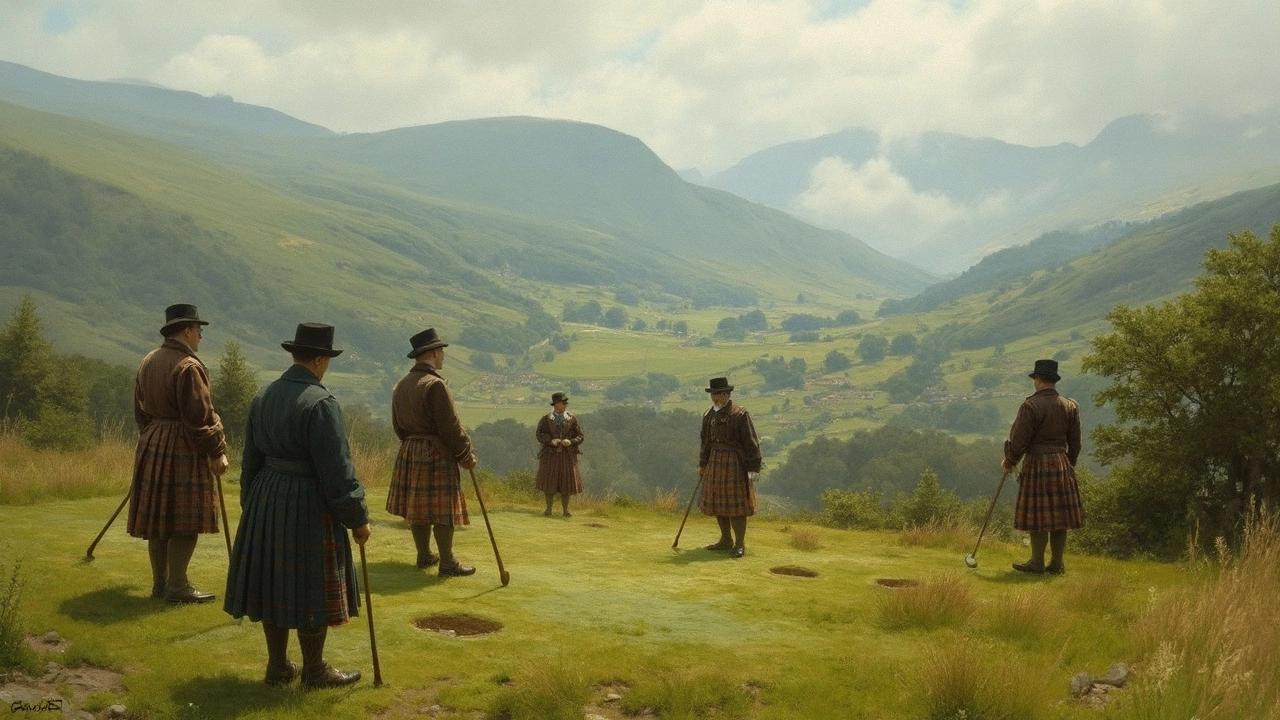Why is Golf 18 Holes? Uncovering the History and Logic
 Mar, 27 2025
Mar, 27 2025
Ever stopped to think, "Why does golf have 18 holes, anyway?" You're not alone. It’s a question many have, especially when you're only halfway through a round and wondering what determined this number.
The story takes us back to Scotland, the home of golf, where the game began on the links of St. Andrews. Back in the day, courses had varied lengths and numbers of holes. St. Andrews itself originally had 22! So why the change to 18? It turns out that, in 1764, they wanted a course that could fit snugly into the existing landscape, trimming it down to 18 holes made sense.
Why did 18 catch on everywhere else? Simple: when something works, people stick with it. As golf grew, other courses adopted the St. Andrews template. Over time, 18 holes became the gold standard, synonymous with the game. Kind of like how 90 minutes became standard for soccer matches—tradition has a funny way of taking hold.
Swinging into the present, not all courses hold tight to the 18-hole tradition. There are 9-hole courses and even some that offer variations to keep things fresh and accessible. It shows that while traditions are strong, fun might sometimes trump history.
- The Beginnings of Golf
- Why 18 Holes?
- Scotland's Role in Shaping Modern Golf
- How 18 Holes Became the Norm
- Modern Variations in Golf Courses
- Interesting Facts and Game Tips
The Beginnings of Golf
Golf's roots are intriguingly tangled in the landscapes of Scotland. Way back in the 15th century, shepherds amusingly knocked around stones into rabbit holes on the famous sand dunes—known as links. This simple pastime gave way to something much grander.
Tracing the history of golf courses takes us to the historic St. Andrews, often hailed as the "Home of Golf." These courses didn’t start with the regulated 18 holes we recognize today. St. Andrews itself had 22 holes till 1764, when club officials decided to combine the first four short holes into two. This cut the course down to the magical 18, creating a ripple effect across the golfing world.
Want to guess how popular this game became? Well, the demand was so high that in 1457, King James II of Scotland actually banned it! Turns out, his soldiers were getting a bit too obsessed with golfing instead of practicing archery.
By the 18th century, as the Scots set their sites far beyond their borders, the game followed them. Golf's appeal spread across Europe and eventually to America. Golfers started using wooden clubs made from beech and balls stuffed with feathers. It was a time when the game was more about ingenuity than gear.
By the end of the 19th century, golf had established itself not just as a pastime, but a staple sport. Names like the Royal and Ancient Golf Club of St. Andrews began to carry weight, and suddenly, the pastime of knocking stones around the fields became a global phenomenon.
Why 18 Holes?
The journey to the standard 18 holes is full of quirks and practicality more than anything else. It started with the iconic Old Course at St. Andrews, which initially had 22 holes. But in 1764, they decided to combine some shorter holes, cutting it down to the now-famous 18 holes.
Legend has it that an 18-hole round was equivalent to the amount of alcohol in a standard bottle of scotch whiskey. A drink could be had after every hole! While a fun story, the reality was about using the land efficiently and providing a manageable length of play.
"The decision was as much about landscape and strategy as it was about tradition," says St. Andrews Links Trust historian David Joy.
By the 19th century, golf courses started standardizing around this number as they wanted to match the fame of St. Andrews. The Royal and Ancient Golf Club, a leading governing body since 1754, played a role in promoting this structure, reinforcing 18 holes as a universal standard.
This adoption mirrored growing consistency in game rules and equipment, helping players know what to expect as they traveled to play different courses.
Still, some courses play it a little differently today. You might find 9-hole courses or setups that throw in an extra challenge or two. And that's great—variety is the spice of life they say!
Scotland's Role in Shaping Modern Golf
If you've ever had a Scottish breakfast overlooking a misty golf course, you might feel that Scotland’s got deep roots in the game. It's more than just a feeling—it's fact. The modern game of golf was born amidst the rolling greens of Scotland.
Back in the 15th century, golf was played in a form that's quite similar to what we know today. Initially, though, they'd play on anything resembling a course. St. Andrews, the grand old stage of golf, had a hand in changing this. The course there, originally 22 holes, became a standard when in 1764 it was tweaked to just 18.
This transition didn’t just happen overnight, and it didn’t go unnoticed. Once St. Andrews set the bar, other clubs saw the practicality and followed suit. It’s like the way we all ended up on smartphones after seeing how handy they were—it just made sense.
Scotland also introduced the governing rules. The Royal and Ancient Golf Club of St. Andrews, established in 1754, became the game’s center of rule-making. Today, The R&A continues to guide the rules worldwide, coordinating with the United States Golf Association.
And let’s not forget the Open Championship, first held in 1860 at Prestwick Golf Club. This championship stamped Scotland as the heartland of golf, cementing its influence on how the game evolved globally.
With all this, it's no wonder people associate golf courses with Scotland. If you're a fan of the game, visiting iconic Scottish courses is like a pilgrimage. They don’t call it the home of golf for nothing!

How 18 Holes Became the Norm
So, how did 18 holes become golf's magic number? It wasn't some grand design at first. Golf's standard wasn't always set in stone. Originally, courses varied all over the place with 5, 7, or even 12 holes. It's hard to believe now, but a round could be whatever the local course had.
The pivotal change happened in 1764 at the Old Course at St. Andrews. This location is famous not just because it's old-school, but because it was the trendsetter. Originally, they had a mix of holes totaling 22. To streamline the play, they combined some smaller holes into larger ones, officially sticking with 18 holes.
Word traveled fast, and golfers began to follow suit, seeing the practicality in St. Andrews' approach. By the late 19th century, anyone designing a new course looked to the Scots for guidance. They weren't about to mess with a working formula.
As more golf clubs popped up across the globe, especially in England and the United States, this 18-hole template was copied so extensively it became the unwritten rule. It's sort of like the QWERTY keyboard—once everybody's using it, it becomes the standard by default.
Bet you didn’t know this iconic number was more habit than heavenly mandate. Next time you're tallying up strokes, you’ll have this bit of history to impress your golf buddies!
Modern Variations in Golf Courses
Not all golf courses stick to the traditional 18 holes these days. Many are shaking things up, creating different experiences for players. One popular alternative is the 9-hole course. These are perfect for folks who want a quicker game or are just starting out. You can still get a great workout and practice your skills without spending the whole day on the links.
Then there are the innovative par-3 courses. These courses are generally smaller and faster to play, focusing more on short-game skills. They're great for honing your precision and can be less intimidating for new players.
Some courses even experiment with golf course setups like executive courses, which blend shorter pars with a few longer holes to offer a varied experience that doesn’t require 18 holes. It's these options that make the game more accessible, ensuring that everyone, regardless of skill or time commitment, can enjoy a round.
By the way, did you know that some courses utilize alternative layouts? During tournaments, a course might rearrange tees and greens to create a different experience. This keeps even the most prestigious courses fresh and challenging, showcasing how versatile golf courses can be.
For those tech-savvy golfers out there, virtual golf centers are another variation. It's golf minus the weather hassles, using simulators to replicate famous courses worldwide. Imagine tackling the iconic holes of Augusta National without leaving your hometown!
Here's a quick look at some varieties:
- 9-Hole Courses – Quicker games, often more relaxing.
- Par-3 Courses – Focus on short-game skills.
- Executive Courses – Mix of par lengths for a diverse game.
- Virtual Golf – Play any famous course inside a cozy simulator.
Whether you're tight on time or just want to switch things up, these modern variations offer plenty of ways to enjoy the sport without sticking to the standard 18 holes every time.
Interesting Facts and Game Tips
Getting to know golf isn’t just about playing; it’s about appreciating the quirks of the game. One quirky fact: Did you know that on a regulation 18-hole golf course, players typically walk about three to six miles? All that walking counts as great exercise!
Here’s a thought for your next game: If you find yourself getting tired halfway through those 18 holes, maybe it’s time for a short break. That’s what many pros do—hit ‘pause’ at the 9th hole to recharge with a quick snack or drink and keep their focus sharp.
Let’s sprinkle in some history to bring a little magic to your swing. Amateur golfer Richard Tufts once said golf was a game played on “the wind-swept dunes of Scotland.” While that might sound poetic, it highlights another fun fact: links courses, usually near the coastline with sand dunes and few trees, are considered the oldest style of golf courses.
If you're curious about the structure of the holes, here’s an interesting tidbit: The famous 18-hole round is often designed around a balance of par 3s, 4s, and 5s to test a player’s skill across different hole types. This combination keeps the game challenging and exciting.
- Par 3: Shorter, demanding precision.
- Par 4: Middle ground, often a favorite.
- Par 5: Longer, potential for an impressive birdie.
For those who like numbers, check this out. According to the National Golf Foundation, as of 2022, there are over 38,000 golf courses worldwide providing a variety of challenges for all skill levels. So, if your local 18-hole course isn’t your flavor, there’s always another course to explore!
Remember, the key to enjoying golf is not just about hitting every shot perfectly—it’s about the camaraderie and the beautiful outdoor settings. So, grab that putter and take it one hole at a time!